An official website of the United States government
 United States Department of Labor
United States Department of Labor
Apply knowledge of healthcare and information systems to assist in the design, development, and continued modification and analysis of computerized healthcare systems. Abstract, collect, and analyze treatment and followup information of patients. May educate staff and assist in problem solving to promote the implementation of the healthcare information system. May design, develop, test, and implement databases with complete history, diagnosis, treatment, and health status to help monitor diseases. Excludes “Medical Records Specialists” (29-2072).
Employment estimate and mean wage estimates for Health Information Technologists and Medical Registrars:
| Employment (1) | Employment RSE (3) |
Mean hourly wage |
Mean annual wage (2) |
Wage RSE (3) |
|---|---|---|---|---|
| 34,430 | 1.4 % | $ 33.78 | $ 70,260 | 0.6 % |
Percentile wage estimates for Health Information Technologists and Medical Registrars:
| Percentile | 10% | 25% | 50% (Median) |
75% | 90% |
|---|---|---|---|---|---|
| Hourly Wage | $ 18.42 | $ 22.39 | $ 30.28 | $ 41.81 | $ 51.75 |
| Annual Wage (2) | $ 38,310 | $ 46,580 | $ 62,990 | $ 86,950 | $ 107,650 |
Industries with the highest published employment and wages for Health Information Technologists and Medical Registrars are provided. For a list of all industries with employment in Health Information Technologists and Medical Registrars, see the Create Customized Tables function.
Industries with the highest levels of employment in Health Information Technologists and Medical Registrars:
| Industry | Employment (1) | Percent of industry employment | Hourly mean wage | Annual mean wage (2) |
|---|---|---|---|---|
| General Medical and Surgical Hospitals | 16,680 | 0.29 | $ 33.46 | $ 69,600 |
| Offices of Physicians | 3,440 | 0.12 | $ 27.45 | $ 57,090 |
| Management of Companies and Enterprises | 2,970 | 0.11 | $ 37.36 | $ 77,720 |
| Outpatient Care Centers | 1,230 | 0.12 | $ 34.83 | $ 72,450 |
| Office Administrative Services | 840 | 0.15 | $ 37.69 | $ 78,390 |
Industries with the highest concentration of employment in Health Information Technologists and Medical Registrars:
| Industry | Employment (1) | Percent of industry employment | Hourly mean wage | Annual mean wage (2) |
|---|---|---|---|---|
| General Medical and Surgical Hospitals | 16,680 | 0.29 | $ 33.46 | $ 69,600 |
| Psychiatric and Substance Abuse Hospitals | 540 | 0.23 | $ 27.17 | $ 56,520 |
| Specialty (except Psychiatric and Substance Abuse) Hospitals | 560 | 0.20 | $ 35.39 | $ 73,620 |
| Office Administrative Services | 840 | 0.15 | $ 37.69 | $ 78,390 |
| Outpatient Care Centers | 1,230 | 0.12 | $ 34.83 | $ 72,450 |
Top paying industries for Health Information Technologists and Medical Registrars:
| Industry | Employment (1) | Percent of industry employment | Hourly mean wage | Annual mean wage (2) |
|---|---|---|---|---|
| Pharmaceutical and Medicine Manufacturing | 40 | 0.01 | $ 91.31 | $ 189,930 |
| Scientific Research and Development Services | 470 | 0.05 | $ 63.18 | $ 131,410 |
| Agencies, Brokerages, and Other Insurance Related Activities | 120 | 0.01 | $ 47.07 | $ 97,910 |
| Computer Systems Design and Related Services | 690 | 0.03 | $ 39.80 | $ 82,790 |
| Grantmaking and Giving Services | (8) | (8) | $ 39.79 | $ 82,770 |
States and areas with the highest published employment, location quotients, and wages for Health Information Technologists and Medical Registrars are provided. For a list of all areas with employment in Health Information Technologists and Medical Registrars, see the Create Customized Tables function.
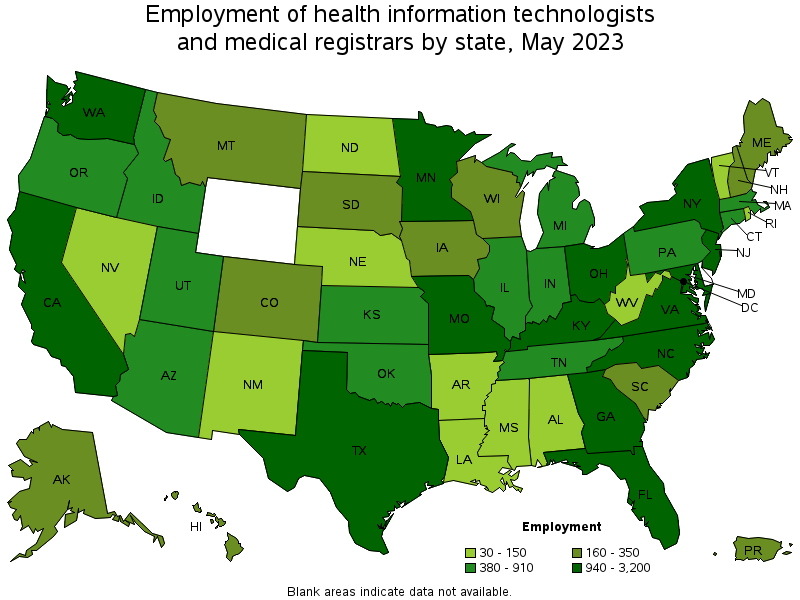
States with the highest employment level in Health Information Technologists and Medical Registrars:
| State | Employment (1) | Employment per thousand jobs | Location quotient (9) | Hourly mean wage | Annual mean wage (2) |
|---|---|---|---|---|---|
| Texas | 3,200 | 0.24 | 1.04 | $ 37.15 | $ 77,270 |
| Florida | 3,060 | 0.32 | 1.41 | $ 33.98 | $ 70,680 |
| California | 2,780 | 0.16 | 0.68 | $ 48.57 | $ 101,030 |
| Maryland | 1,610 | 0.60 | 2.65 | $ 38.55 | $ 80,170 |
| New York | 1,440 | 0.15 | 0.68 | $ 35.91 | $ 74,690 |
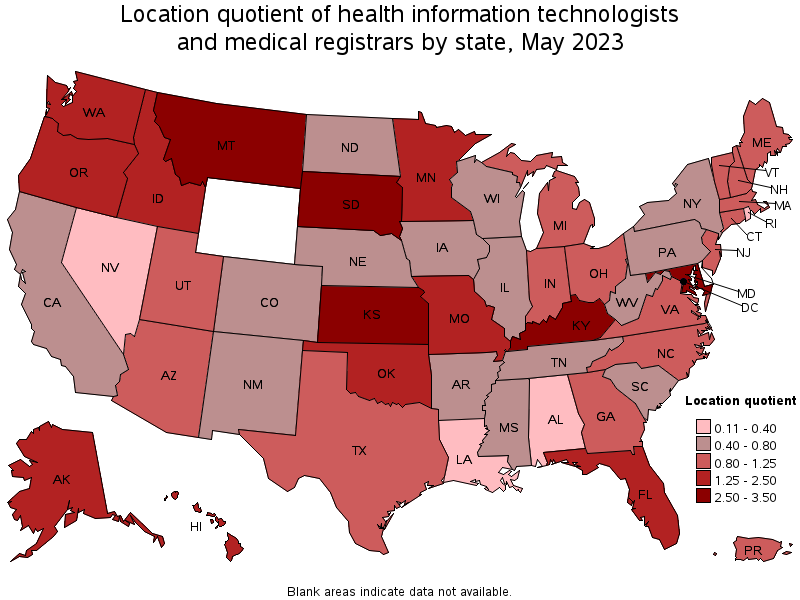
States with the highest concentration of jobs and location quotients in Health Information Technologists and Medical Registrars:
| State | Employment (1) | Employment per thousand jobs | Location quotient (9) | Hourly mean wage | Annual mean wage (2) |
|---|---|---|---|---|---|
| South Dakota | 300 | 0.68 | 3.00 | $ 28.53 | $ 59,330 |
| Kentucky | 1,230 | 0.63 | 2.77 | $ 28.91 | $ 60,140 |
| Maryland | 1,610 | 0.60 | 2.65 | $ 38.55 | $ 80,170 |
| Kansas | 830 | 0.58 | 2.58 | $ 33.82 | $ 70,340 |
| Montana | 290 | 0.58 | 2.54 | $ 33.72 | $ 70,130 |
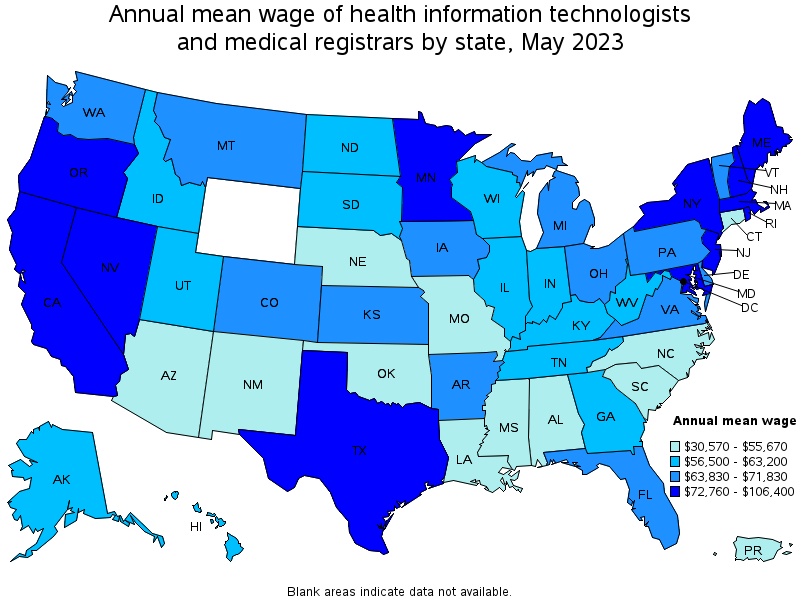
Top paying states for Health Information Technologists and Medical Registrars:
| State | Employment (1) | Employment per thousand jobs | Location quotient (9) | Hourly mean wage | Annual mean wage (2) |
|---|---|---|---|---|---|
| Rhode Island | 30 | 0.06 | 0.29 | $ 51.15 | $ 106,400 |
| California | 2,780 | 0.16 | 0.68 | $ 48.57 | $ 101,030 |
| District of Columbia | 80 | 0.11 | 0.49 | $ 41.71 | $ 86,750 |
| Massachusetts | 700 | 0.19 | 0.85 | $ 41.22 | $ 85,740 |
| Minnesota | 1,020 | 0.35 | 1.55 | $ 40.80 | $ 84,870 |
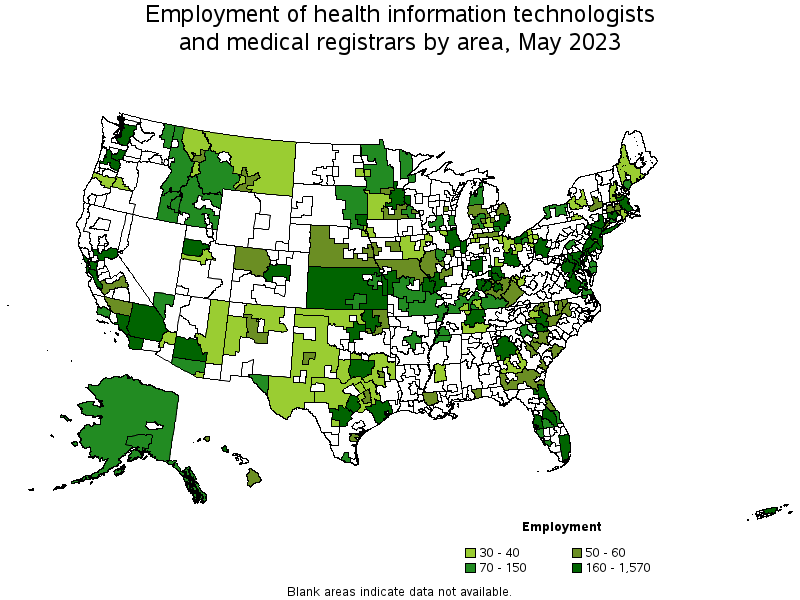
Metropolitan areas with the highest employment level in Health Information Technologists and Medical Registrars:
| Metropolitan area | Employment (1) | Employment per thousand jobs | Location quotient (9) | Hourly mean wage | Annual mean wage (2) |
|---|---|---|---|---|---|
| New York-Newark-Jersey City, NY-NJ-PA | 1,570 | 0.17 | 0.73 | $ 37.86 | $ 78,750 |
| Los Angeles-Long Beach-Anaheim, CA | 1,020 | 0.17 | 0.73 | $ 45.52 | $ 94,690 |
| Washington-Arlington-Alexandria, DC-VA-MD-WV | 970 | 0.31 | 1.39 | $ 39.77 | $ 82,710 |
| Seattle-Tacoma-Bellevue, WA | 970 | 0.47 | 2.05 | $ 31.82 | $ 66,180 |
| Miami-Fort Lauderdale-West Palm Beach, FL | 890 | 0.33 | 1.45 | $ 34.61 | $ 72,000 |
| Dallas-Fort Worth-Arlington, TX | 890 | 0.22 | 0.99 | $ 37.28 | $ 77,540 |
| Baltimore-Columbia-Towson, MD | 820 | 0.63 | 2.76 | $ 36.68 | $ 76,300 |
| Houston-The Woodlands-Sugar Land, TX | 780 | 0.24 | 1.08 | $ 37.49 | $ 77,970 |
| Kansas City, MO-KS | 660 | 0.62 | 2.72 | $ 32.51 | $ 67,620 |
| Minneapolis-St. Paul-Bloomington, MN-WI | 550 | 0.29 | 1.28 | $ 41.05 | $ 85,380 |
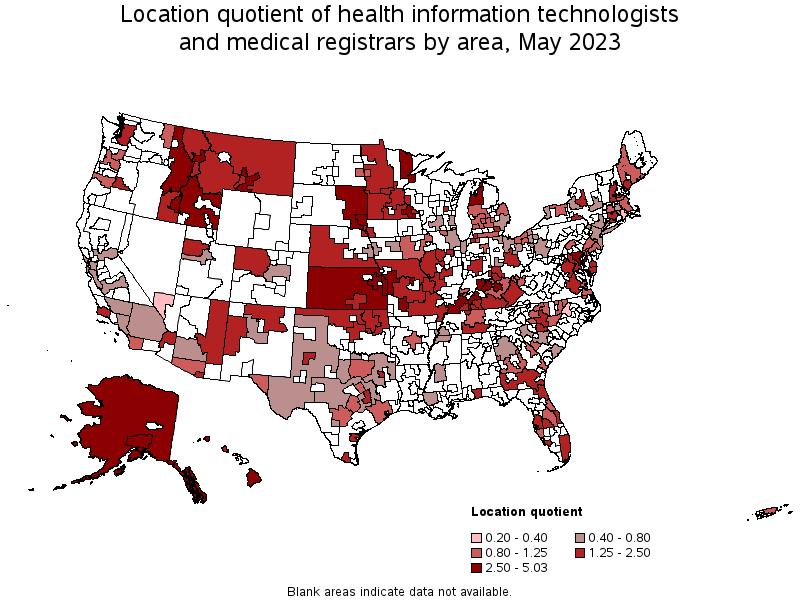
Metropolitan areas with the highest concentration of jobs and location quotients in Health Information Technologists and Medical Registrars:
| Metropolitan area | Employment (1) | Employment per thousand jobs | Location quotient (9) | Hourly mean wage | Annual mean wage (2) |
|---|---|---|---|---|---|
| Columbia, MO | 110 | 1.14 | 5.03 | $ 22.64 | $ 47,100 |
| Topeka, KS | 120 | 1.05 | 4.63 | $ 39.80 | $ 82,790 |
| Sioux Falls, SD | 160 | 0.99 | 4.35 | $ 30.23 | $ 62,870 |
| Lexington-Fayette, KY | 250 | 0.90 | 3.98 | $ 30.87 | $ 64,210 |
| Missoula, MT | 50 | 0.83 | 3.67 | $ 30.12 | $ 62,650 |
| Rochester, MN | 100 | 0.82 | 3.63 | $ 41.43 | $ 86,170 |
| Duluth, MN-WI | 90 | 0.75 | 3.30 | $ 40.40 | $ 84,020 |
| Louisville/Jefferson County, KY-IN | 490 | 0.74 | 3.25 | $ 31.15 | $ 64,800 |
| Springfield, MO | 150 | 0.71 | 3.13 | $ 21.45 | $ 44,620 |
| Billings, MT | 60 | 0.69 | 3.02 | $ 35.14 | $ 73,080 |
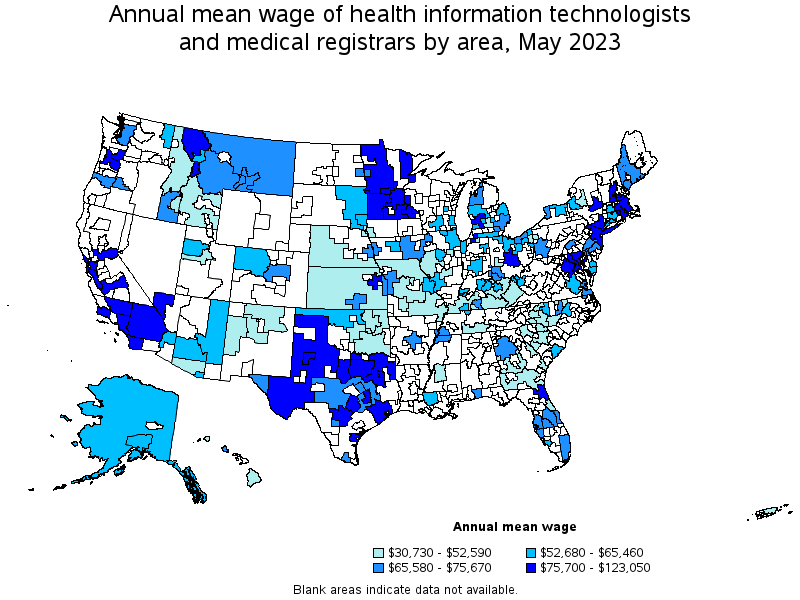
Top paying metropolitan areas for Health Information Technologists and Medical Registrars:
| Metropolitan area | Employment (1) | Employment per thousand jobs | Location quotient (9) | Hourly mean wage | Annual mean wage (2) |
|---|---|---|---|---|---|
| San Jose-Sunnyvale-Santa Clara, CA | 170 | 0.15 | 0.66 | $ 59.16 | $ 123,050 |
| San Francisco-Oakland-Hayward, CA | 320 | 0.13 | 0.58 | $ 57.97 | $ 120,580 |
| Santa Maria-Santa Barbara, CA | 80 | 0.40 | 1.75 | $ 56.86 | $ 118,270 |
| Providence-Warwick, RI-MA | 40 | 0.06 | 0.28 | $ 49.32 | $ 102,590 |
| Sacramento--Roseville--Arden-Arcade, CA | 180 | 0.17 | 0.76 | $ 49.26 | $ 102,460 |
| San Diego-Carlsbad, CA | 380 | 0.25 | 1.10 | $ 48.99 | $ 101,910 |
| Fresno, CA | 60 | 0.15 | 0.67 | $ 48.01 | $ 99,860 |
| St. Cloud, MN | 60 | 0.55 | 2.41 | $ 45.60 | $ 94,850 |
| Los Angeles-Long Beach-Anaheim, CA | 1,020 | 0.17 | 0.73 | $ 45.52 | $ 94,690 |
| South Bend-Mishawaka, IN-MI | 40 | 0.35 | 1.52 | $ 44.74 | $ 93,050 |
Nonmetropolitan areas with the highest employment in Health Information Technologists and Medical Registrars:
| Nonmetropolitan area | Employment (1) | Employment per thousand jobs | Location quotient (9) | Hourly mean wage | Annual mean wage (2) |
|---|---|---|---|---|---|
| Kansas nonmetropolitan area | 240 | 0.63 | 2.76 | $ 24.14 | $ 50,220 |
| West Kentucky nonmetropolitan area | 90 | 0.62 | 2.74 | $ 21.34 | $ 44,390 |
| Northwest Lower Peninsula of Michigan nonmetropolitan area | 90 | 0.76 | 3.35 | $ 32.79 | $ 68,190 |
| South Central Kentucky nonmetropolitan area | 90 | 0.53 | 2.34 | $ 24.27 | $ 50,480 |
| Central Missouri nonmetropolitan area | 90 | 0.56 | 2.46 | $ 21.74 | $ 45,230 |
Nonmetropolitan areas with the highest concentration of jobs and location quotients in Health Information Technologists and Medical Registrars:
| Nonmetropolitan area | Employment (1) | Employment per thousand jobs | Location quotient (9) | Hourly mean wage | Annual mean wage (2) |
|---|---|---|---|---|---|
| Northwestern Idaho nonmetropolitan area | 70 | 0.90 | 3.95 | $ 21.98 | $ 45,720 |
| Southeast-Central Idaho nonmetropolitan area | 80 | 0.89 | 3.93 | $ 20.98 | $ 43,630 |
| Northwest Lower Peninsula of Michigan nonmetropolitan area | 90 | 0.76 | 3.35 | $ 32.79 | $ 68,190 |
| Alaska nonmetropolitan area | 70 | 0.67 | 2.94 | $ 31.21 | $ 64,910 |
| Kansas nonmetropolitan area | 240 | 0.63 | 2.76 | $ 24.14 | $ 50,220 |
Top paying nonmetropolitan areas for Health Information Technologists and Medical Registrars:
| Nonmetropolitan area | Employment (1) | Employment per thousand jobs | Location quotient (9) | Hourly mean wage | Annual mean wage (2) |
|---|---|---|---|---|---|
| North Texas Region of Texas nonmetropolitan area | 40 | 0.15 | 0.68 | $ 42.75 | $ 88,920 |
| Northwest Minnesota nonmetropolitan area | 70 | 0.36 | 1.57 | $ 39.97 | $ 83,130 |
| Southwest Minnesota nonmetropolitan area | 40 | 0.35 | 1.53 | $ 39.53 | $ 82,220 |
| Southeast Minnesota nonmetropolitan area | 50 | 0.36 | 1.57 | $ 39.15 | $ 81,440 |
| West Montana nonmetropolitan area | 40 | 0.46 | 2.01 | $ 37.64 | $ 78,290 |
These estimates are calculated with data collected from employers in all industry sectors, all metropolitan and nonmetropolitan areas, and all states and the District of Columbia. The top employment and wage figures are provided above. The complete list is available in the downloadable XLS files.
The percentile wage estimate is the value of a wage below which a certain percent of workers fall. The median wage is the 50th percentile wage estimate—50 percent of workers earn less than the median and 50 percent of workers earn more than the median. More about percentile wages.
(1) Estimates for detailed occupations do not sum to the totals because the totals include occupations not shown separately. Estimates do not include self-employed workers.
(2) Annual wages have been calculated by multiplying the hourly mean wage by a "year-round, full-time" hours figure of 2,080 hours; for those occupations where there is not an hourly wage published, the annual wage has been directly calculated from the reported survey data.
(3) The relative standard error (RSE) is a measure of the reliability of a survey statistic. The smaller the relative standard error, the more precise the estimate.
(8) Estimate not released.
(9) The location quotient is the ratio of the area concentration of occupational employment to the national average concentration. A location quotient greater than one indicates the occupation has a higher share of employment than average, and a location quotient less than one indicates the occupation is less prevalent in the area than average.
Other OEWS estimates and related information:
May 2023 National Occupational Employment and Wage Estimates
May 2023 State Occupational Employment and Wage Estimates
May 2023 Metropolitan and Nonmetropolitan Area Occupational Employment and Wage Estimates
May 2023 National Industry-Specific Occupational Employment and Wage Estimates
Last Modified Date: April 3, 2024